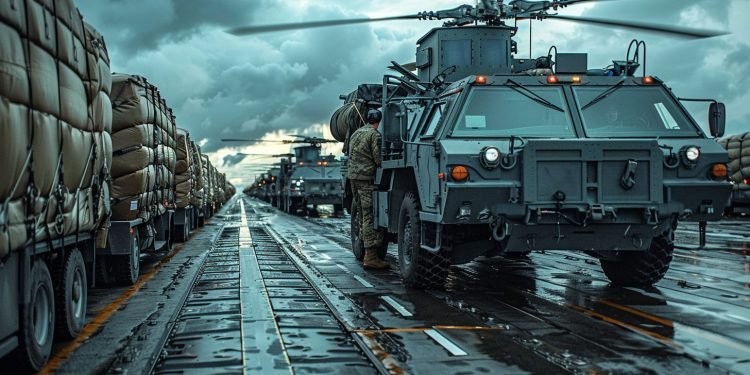According to Technavio, the global defense logistics market is expected to witness a significant growth of USD 3.95 billion from 2024 to 2028. The market is projected to expand at a CAGR of 2.01% during the forecast period. Defense logistics entails providing crucial services and resources for the establishment and maintenance of temporary overseas base camps, encompassing activities such as security, community services, communication, and transportation, all of which incur high costs. To mitigate these expenses, many defense organizations, like the British army, are downsizing their operational base camps. Key players in this market include L3Harris Technologies and Gulfstream Aerospace, offering procurement solutions, logistics services, and technology integration. Focus areas also extend to commodity security, cybersecurity, infrastructure, automation, data analytics, and energy efficiency. Notably, the end-user segment emerges as the fastest-growing segment in the defense logistics market.
The Defense Logistics Market involves the strategic planning and management of resources, procedures, and assets for military organizations. This encompasses Defense Logistics Outsourcing to Defense Logistics Providers, who offer logistics support, infrastructure development, and technology integration. Defense Logistics Infrastructure optimization, such as barracks, airfields, and communication facilities, is achieved through Defense Logistics Technology, including network-centric warfare communication. Defense Logistics Planning addresses requirements, efficiency, integration, and capability aspects. Challenges such as geopolitical tension and military conflicts necessitate Defense Logistics Modernization and Innovation for optimization and resilience. Defense Logistics Contracts and Companies facilitate Defense Logistics Procurement of ammunition, vehicles, and other resources. Growth and forecasting in Defense Logistics are influenced by government defense expenditure, military modernization programs, and sustainability initiatives, including environmentally friendly practices and various transportation modes.
Strategic planning is paramount in the realm of defense logistics to manage complex supply chains and ensure military readiness. The Defense Logistics Management (DLM) sector involves Defense Logistics Outsourcing (DLO) to Defense Logistics Providers (DLPs), who provide logistics support through Defense Logistics Infrastructure (DLI), technology, and networks. Defense Logistics Planning (DLP) encompasses addressing efficiency, requirements, integration, and trends through Defense Logistics Contracts (DLCs) and Defense Logistics Companies (DLCs). Military strength relies on Defense Logistics Modernization (DLM), Innovation, Optimization, and Resilience, with key focus areas including Defense Logistics Capability (DLC), Performance, Coordination, Cost, Procurement, and Forecast. Geopolitical tension and military conflicts underscore the importance of sustainability and environmentally friendly practices in Defense Logistics. Transportation modes, including ammunition, vehicles, resources, procedures, assets, and systems, are integral components, shaped by military strength, Defense Logistics Planning, and Defense Logistics Performance. Government defense expenditure propels Military modernization programs, driving the need for Defense Logistics Growth, with trends leaning towards the increasing importance of Defense Logistics Technology and integration of Defense Logistics Networks. Challenges in Defense Logistics include cost control, supply chain disruptions, and interoperability between Defense Logistics Providers, highlighting the significance of Defense Logistics Efficiency and Optimization in maintaining military readiness and ensuring Defense Logistics Integration.
A Senior Analyst of Technavio commented on market trends, stating, “Geopolitical instability from 2020-2025 underscored a significant focus on defense logistics globally. Key issues included military transportation and logistics collaboration, US Army relationships with Middle Eastern and North African countries, and the UAE’s strategic role as a defense logistics partner. Defense logistics encompassed planning, outsourcing, infrastructure, technology, and challenges, with trends toward modernization, optimization, and sustainability. Key areas included ammunition, vehicles, and resources, with a focus on military strength, government defense expenditure, and supply chain efficiency.”
Analyst Review
The Defense Logistics Market plays a critical role in the Defense Sector, providing essential Procurement Solutions and Logistics Services to support Military Operations. Effective Supply Chain Management is pivotal in ensuring the readiness of military forces and maintaining national security. Defense Contractors are key stakeholders, supplying various products and solutions to meet the unique demands of the Defense Industry. The Defense Logistics Market continues to evolve, driven by technological advancements and the demand for more efficient and cost-effective solutions.
Market Overview
The Defense Logistics Market is instrumental in providing essential supplies and services to military forces. Procurement of resources, including food, vehicles, and technology, involves various procedures governed by contracts between defense organizations and manufacturers. Additionally, military logistics encompasses the storage, distribution, and transportation of these resources to various locations. The use of modern technology and systems has streamlined military logistics, making it more efficient and effective. The Defense Logistics Agency (DLA) plays a significant role in this market, managing a vast inventory of supplies and equipment for the US military. The defense industry is continuously evolving, and the Defense Logistics Market adapts to these changes, providing innovative solutions to meet the needs of military organizations.
About Technavio
Technavio is a leading global technology research and advisory company providing actionable insights to help businesses identify market opportunities and develop effective strategies to optimize their market positions. With over 500 specialized analysts, Technavio’s report library consists of more than 17,000 reports and counting, covering 800 technologies across 50 countries. Their client base includes enterprises of all sizes, including more than 100 Fortune 500 companies, relying on Technavio’s comprehensive coverage, extensive research, and actionable market insights to navigate changing market dynamics.























